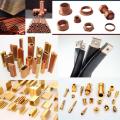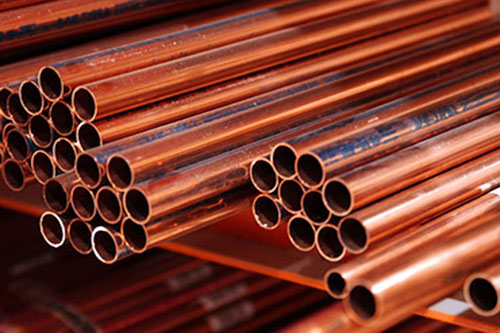In 1751, A.F. Cronstedt succeeded in isolating nickel. However, Cu-Ni alloys were in existence much earlier, mostly prepared by processing ores. Today, Cu-Ni alloys have gained a variety of interestin... View MoreIn 1751, A.F. Cronstedt succeeded in isolating nickel. However, Cu-Ni alloys were in existence much earlier, mostly prepared by processing ores. Today, Cu-Ni alloys have gained a variety of interesting applications because of their specific characteristics.
Copper and nickel are adjacent to one another in the periodic system of elements, with atomic numbers 29 and 28 and atomic weights 63.54 and 68.71. The two elements are closely related and are completely miscible in both the liquid and solid-state. Cu-Ni alloys crystallize over the whole concentration range in a face-centered cubic lattice. The lattice spacing of the face-center cubic solid solution varies almost linearly with an atomic concentration between the values for copper (3.6153 . 10-8cm) and that for nickel (3.5238 . 10-8cm).
Cu-Ni alloys are alloys of copper (base metal with the largest individual content) and nickel with or without other elements, whereby the zinc content may not be more than 1%. When other elements are present, nickel has the largest individual content after copper, compared with each other element.
Key Properties
Properties of copper-nickel alloys vary with composition, however, some properties of copper-nickel alloys are outlined below.
Copper-Nickel alloy Copper 90/10 and Copper 70/30
Outstanding resistance to corrosion, particularly seawater
70/30 is stronger and has superior resistance to impingement corrosion
Good resistance to biofouling, with the 90/10 alloy being slightly superior compared to the 70/30 alloy
Copper rich alloys are:
Ductile
Can be hardened only by cold working
Good corrosion resistance
Good strength
Low-temperature co-efficient of electrical resistance
The nickel content in these copper-nickel alloys also enables them to retain their strength at elevated temperatures compared to copper alloys without nickel.
Applications of Copper-Nickel alloys
Sea Water Condensor Systems And Desalination Plants
Due to the good resistance to seawater corrosion, the copper-nickel alloy Copper 90/10 and copper-nickel alloy Copper 70/30 are employed for seawater condenser systems and in desalination plants, as well as pipework in chemical plants.
Automotive Applications
Due to the fact that the copper-nickel alloy Copper 90/10 requires no surface protection and hence gives extra safety, this copper-nickel alloy is being increasingly employed for brake and hydraulic suspension systems and cooling systems in cars and commercial vehicles.
Marine Applications
The good resistance to biofouling and seawater corrosion resistance of the copper-nickel alloys, Copper 90/10 and Copper 70/30 alloys have to lead to its use in applications such as cladding for ships' hulls, legs of oil rig platforms, and seawater intake screens.
Coins
The copper-nickel alloys composed of copper with 25% nickel with 0.05-0.4% manganese is commonly used for the manufacture of coins, medals, and other semi-valuable applications.
Resistance Wire
Due to the very low-temperature co-efficient of electrical resistivity, the copper-nickel alloys composed of copper with 45% nickel alloy is used for resistance wire in high precision resistors. This property of copper-nickel alloys allows the resistor to operate at almost exactly the same resistance regardless of temperature.
Thermocouples
The copper-nickel alloys composed of copper-45% nickel alloy is also used for thermocouples as it develops a high and uniform EMF when coupled with other metals such as copper and iron.
Other Applications
Copper-nickel alloys may be used in cooling circuits, ammunition, seawater corrosion-resistant assemblies, and condenser tubes. They also have cryogenic applications and can be found in materials used by intensive care units where strong anti-microbial properties are essential to reduce cross-contamination and infections. High levels of aluminum, chromium, or tin are introduced to alloys with 30% nickel content for greater resistance to seawater flow, wear, and tear, sand abrasion, and galling. These are also used where higher mechanical properties are required
Before heading out to make a purchase, however, see to it that you will find the best supplier near you. It doesn’t help to source materials from a supplier that isn’t well-versed with metals, particularly copper alloys. The best place to go to is an established supplier like Nexim Alloys. Not only do they specialize in copper alloys but they are also an established business, operating since 2009. With their copious knowledge and experience with copper, they surely provide you with the highest quality copper sheet metal, cupro nickel tubes for sale as well as unparalleled customer service. Nexim Alloy is India's Trusted Manufacturers & Exporters, Supplier Of Constant Force Spring, Copper Flex Bars, Brass & Copper Sheets, Profiles, Sections, Components, Cupro Nickel Tubes in Mumbai.
Visit us here: http://neximalloys.com/
page=1&profile_user_id=367505&year=&month=
Load More


